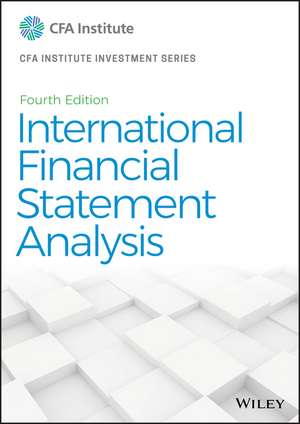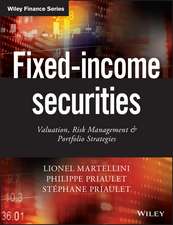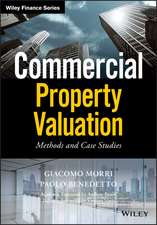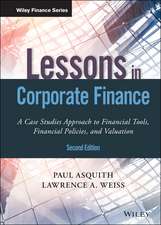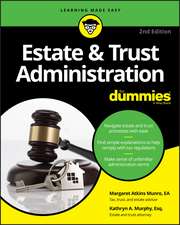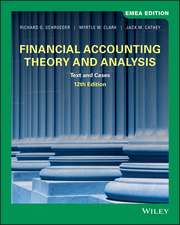International Financial Statement Analysis, Fourth Edition (CFA Institute Investment Series): CFA Institute Investment Series
Autor TR Robinsonen Limba Engleză Hardback – 8 mar 2020
Din seria CFA Institute Investment Series
- 19%
 Preț: 557.37 lei
Preț: 557.37 lei - 24%
 Preț: 562.79 lei
Preț: 562.79 lei -
 Preț: 349.41 lei
Preț: 349.41 lei -
 Preț: 323.21 lei
Preț: 323.21 lei - 24%
 Preț: 575.53 lei
Preț: 575.53 lei - 24%
 Preț: 553.61 lei
Preț: 553.61 lei - 23%
 Preț: 705.77 lei
Preț: 705.77 lei - 24%
 Preț: 555.51 lei
Preț: 555.51 lei - 24%
 Preț: 552.39 lei
Preț: 552.39 lei -
 Preț: 325.40 lei
Preț: 325.40 lei -
 Preț: 290.70 lei
Preț: 290.70 lei -
 Preț: 281.88 lei
Preț: 281.88 lei - 8%
 Preț: 625.00 lei
Preț: 625.00 lei - 8%
 Preț: 588.62 lei
Preț: 588.62 lei -
 Preț: 293.69 lei
Preț: 293.69 lei - 8%
 Preț: 634.40 lei
Preț: 634.40 lei -
 Preț: 282.43 lei
Preț: 282.43 lei - 28%
 Preț: 518.58 lei
Preț: 518.58 lei - 29%
 Preț: 230.99 lei
Preț: 230.99 lei - 29%
 Preț: 228.53 lei
Preț: 228.53 lei - 28%
 Preț: 523.28 lei
Preț: 523.28 lei - 28%
 Preț: 234.21 lei
Preț: 234.21 lei - 28%
 Preț: 233.68 lei
Preț: 233.68 lei - 29%
 Preț: 229.87 lei
Preț: 229.87 lei
Preț: 578.66 lei
Preț vechi: 761.39 lei
-24% Nou
Puncte Express: 868
Preț estimativ în valută:
110.74€ • 120.25$ • 93.02£
110.74€ • 120.25$ • 93.02£
Carte disponibilă
Livrare economică 01-15 aprilie
Livrare express 15-21 martie pentru 64.71 lei
Preluare comenzi: 021 569.72.76
Specificații
ISBN-13: 9781119628057
ISBN-10: 1119628059
Pagini: 1008
Dimensiuni: 186 x 254 x 41 mm
Greutate: 1.52 kg
Ediția:4th Edition
Editura: Wiley
Seria CFA Institute Investment Series
Locul publicării:Hoboken, United States
ISBN-10: 1119628059
Pagini: 1008
Dimensiuni: 186 x 254 x 41 mm
Greutate: 1.52 kg
Ediția:4th Edition
Editura: Wiley
Seria CFA Institute Investment Series
Locul publicării:Hoboken, United States
Cuprins
Preface xv Acknowledgments xvii About the CFA Institute Investment Series xix Chapter 1 Introduction to Financial Statement Analysis 1 Learning Outcomes 1 1. Introduction 1 2. Roles of Financial Reporting and Financial Statement Analysis 2 3. Primary Financial Statements and Other Information Sources 8 3.1. Financial Statements and Supplementary Information 9 3.2. Other Sources of Information 28 4. Financial Statement Analysis Framework 28 4.1. Articulate the Purpose and Context of Analysis 30 4.2. Collect Data 30 4.3. Process Data 31 4.4. Analyze/Interpret the Processed Data 31 4.5. Develop and Communicate Conclusions/Recommendations 32 4.6. Follow-Up 32 5. Summary 32 References 34 Practice Problems 34 Chapter 2 Financial Reporting Standards 37 Learning Outcomes 37 1. Introduction 37 2. The Objective of Financial Reporting 38 3. Standard-Setting Bodies and Regulatory Authorities 39 3.1. Accounting Standards Boards 39 3.2. Regulatory Authorities 41 4. The International Financial Reporting Standards Framework 46 4.1. Qualitative Characteristics of Financial Reports 46 4.2. Constraints on Financial Reports 48 4.3. The Elements of Financial Statements 49 4.4. General Requirements for Financial Statements 50 5. Comparison of IFRS with Alternative Reporting Systems 53 6. Monitoring Developments in Financial Reporting Standards 55 6.1. New Products or Types of Transactions 55 6.2. Evolving Standards and the Role of CFA Institute 55 7. Summary 57 Practice Problems 58 Chapter 3 Understanding Income Statements 61 Learning Outcomes 61 1. Introduction 62 2. Components and Format of the Income Statement 62 3. Revenue Recognition 68 3.1. General Principles 69 3.2. Accounting Standards for Revenue Recognition 70 4. Expense Recognition 73 4.1. General Principles 74 4.2. Issues in Expense Recognition 78 4.3. Implications for Financial Analysis 83 5. Non-Recurring Items and Non-Operating Items 84 5.1. Discontinued Operations 84 5.2. Unusual or Infrequent Items 85 5.3. Changes in Accounting Policies 86 5.4. Non-Operating Items 89 6. Earnings per Share 90 6.1. Simple versus Complex Capital Structure 90 6.2. Basic EPS 91 6.3. Diluted EPS 92 6.4. Changes in EPS 98 7. Analysis of the Income Statement 99 7.1. Common-Size Analysis of the Income Statement 99 7.2. Income Statement Ratios 101 8. Comprehensive Income 103 9. Summary 106 Practice Problems 108 Chapter 4 Understanding Balance Sheets 113 Learning Outcomes 113 1. Introduction 113 2. Components and Format of the Balance Sheet 114 2.1. Balance Sheet Components 115 2.2. Current and Non-Current Classification 116 2.3. Liquidity-Based Presentation 117 3. Current Assets and Current Liabilities 118 3.1. Current Assets 118 3.2. Current Liabilities 123 4. Non-Current Assets 127 4.1. Property, Plant, and Equipment 128 4.2. Investment Property 129 4.3. Intangible Assets 129 4.4. Goodwill 132 4.5. Financial Assets 135 4.6. Deferred Tax Assets 138 5. Non-Current Liabilities 139 5.1. Long-term Financial Liabilities 140 5.2. Deferred Tax Liabilities 140 6. Equity 141 6.1. Components of Equity 141 6.2. Statement of Changes in Equity 144 7. Analysis of the Balance Sheet 145 7.1. Common-Size Analysis of the Balance Sheet 146 7.2. Balance Sheet Ratios 153 8. Summary 156 Practice Problems 158 Chapter 5 Understanding Cash Flow Statements 163 Learning Outcomes 163 1. Introduction 163 2. Components and Format of the Cash Flow Statement 164 2.1. Classification of Cash Flows and Non-Cash Activities 165 2.2. A Summary of Differences between IFRS and US GAAP 167 2.3. Direct and Indirect Methods for Reporting Cash Flow from Operating Activities 168 3. The Cash Flow Statement: Linkages and Preparation 177 3.1. Linkages of the Cash Flow Statement with the Income Statement and Balance Sheet 178 3.2. Steps in Preparing the Cash Flow Statement 179 3.3. Conversion of Cash Flows from the Indirect to the Direct Method 191 4. Cash Flow Statement Analysis 192 4.1. Evaluation of the Sources and Uses of Cash 193 4.2. Common-Size Analysis of the Statement of Cash Flows 197 4.3. Free Cash Flow to the Firm and Free Cash Flow to Equity 202 4.4. Cash Flow Ratios 204 5. Summary 205 Practice Problems 206 Chapter 6 Financial Analysis Techniques 213 Learning Outcomes 213 1. Introduction 213 2. The Financial Analysis Process 214 2.1. The Objectives of the Financial Analysis Process 215 2.2. Distinguishing between Computations and Analysis 216 3. Analytical Tools and Techniques 218 3.1. Ratios 221 3.2. Common-Size Analysis 226 3.3. The Use of Graphs as an Analytical Tool 232 3.4. Regression Analysis 233 4. Common Ratios Used in Financial Analysis 234 4.1. Interpretation and Context 234 4.2. Activity Ratios 235 4.3. Liquidity Ratios 241 4.4. Solvency Ratios 246 4.5. Profitability Ratios 250 4.6. Integrated Financial Ratio Analysis 254 5. Equity Analysis 262 5.1. Valuation Ratios 262 5.2. Industry-Specific Ratios 265 5.3. Historical Research on Ratios in Equity Analysis 267 6. Credit Analysis 268 6.1. The Credit Rating Process 268 6.2. Historical Research on Ratios in Credit Analysis 269 7. Business and Geographic Segments 270 7.1. Segment Reporting Requirements 270 7.2. Segment Ratios 271 8. Model Building and Forecasting 274 9. Summary 275 References 275 Practice Problems 276 Chapter 7 Inventories 283 Learning Outcomes 283 1. Introduction 283 2. Cost of Inventories 285 3. Inventory Valuation Methods 286 3.1. Specific Identification 287 3.2. First-In, First-Out (FIFO) 287 3.3. Weighted Average Cost 287 3.4. Last-In, First-Out (LIFO) 288 3.5. Calculation of Cost of Sales, Gross Profit, and Ending Inventory 288 3.6. Periodic versus Perpetual Inventory Systems 290 3.7. Comparison of Inventory Valuation Methods 293 4. The LIFO Method 295 4.1. LIFO Reserve 295 4.2. LIFO Liquidations 296 5. Inventory Method Changes 303 6. Inventory Adjustments 304 7. Evaluation of Inventory Management 311 7.1. Presentation and Disclosure 312 7.2. Inventory Ratios 312 7.3. Financial Analysis Illustrations 313 8. Summary 323 Practice Problems 325 Chapter 8 Long-Lived Assets 339 Learning Outcomes 339 1. Introduction 340 2. Acquisition of Long-Lived Assets 340 2.1. Property, Plant, and Equipment 341 2.2. Intangible Assets 343 2.3. Capitalizing versus Expensing: Impact on Financial Statements and Ratios 348 2.4. Capitalization of Interest Costs 353 2.5. Capitalization of Internal Development Costs 355 3. Depreciation and Amortization of Long-Lived Assets 359 3.1. Depreciation Methods and Calculation of Depreciation Expense 360 3.2. Amortization Methods and Calculation of Amortization Expense 368 4. The Revaluation Model 369 5. Impairment of Assets 373 5.1. Impairment of Property, Plant, and Equipment 373 5.2. Impairment of Intangible Assets with a Finite Life 375 5.3. Impairment of Intangibles with Indefinite Lives 376 5.4. Impairment of Long-Lived Assets Held for Sale 376 5.5. Reversals of Impairments of Long-Lived Assets 376 6. Derecognition 376 6.1. Sale of Long-Lived Assets 377 6.2. Long-Lived Assets Disposed of Other than by a Sale 378 7. Presentation and Disclosures 379 8. Investment Property 389 9. Summary 393 Practice Problems 395 Chapter 9 Income Taxes 407 Learning Outcomes 407 1. Introduction 408 2. Differences between Accounting Profit and Taxable Income 408 2.1. Current Tax Assets and Liabilities 409 2.2. Deferred Tax Assets and Liabilities 410 3. Determining the Tax Base of Assets and Liabilities 413 3.1. Determining the Tax Base of an Asset 414 3.2. Determining the Tax Base of a Liability 415 3.3. Changes in Income Tax Rates 417 4. Temporary and Permanent Differences Between Taxable and Accounting Profit 418 4.1. Taxable Temporary Differences 419 4.2. Deductible Temporary Differences 419 4.3. Examples of Taxable and Deductible Temporary Differences 420 4.4. Temporary Differences at Initial Recognition of Assets and Liabilities 422 4.5. Business Combinations and Deferred Taxes 423 4.6. Investments in Subsidiaries, Branches, Associates, and Interests in Joint Ventures 423 5. Unused Tax Losses and Tax Credits 423 6. Recognition and Measurement of Current and Deferred Tax 424 6.1. Recognition of a Valuation Allowance 425 6.2. Recognition of Current and Deferred Tax Charged Directly to Equity 425 7. Presentation and Disclosure 428 8. Comparison of IFRS and US GAAP 433 9. Summary 436 Practice Problems 437 Chapter 10 Non-Current (Long-Term) Liabilities 443 Learning Outcomes 443 1. Introduction 443 2. Bonds Payable 444 2.1. Accounting for Bond Issuance 444 2.2. Accounting for Bond Amortization, Interest Expense, and Interest Payments 448 2.3. Current Market Rates and Fair Value Reporting Option 453 2.4. Derecognition of Debt 457 2.5. Debt Covenants 459 2.6. Presentation and Disclosure of Long-Term Debt 461 3. Leases 464 3.1. Lessee accounting 465 3.2. Lessor accounting 466 4. Introduction to Pensions and Other Post- Employment Benefits 468 5. Evaluating Solvency: Leverage and Coverage Ratios 472 6. Summary 475 Practice Problems 477 Chapter 11 Financial Reporting Quality 483 Learning Outcomes 483 1. Introduction 484 2. Conceptual Overview 484 2.1. GAAP, Decision-Useful, Sustainable, and Adequate Returns 486 2.2. GAAP, Decision-Useful, but Sustainable? 486 2.3. Biased Accounting Choices 487 2.4. Departures from GAAP 496 2.5. Differentiate between Conservative and Aggressive Accounting 498 3. Context for Assessing Financial Reporting Quality 501 3.1. Motivations 501 3.2. Conditions Conducive to Issuing Low-Quality Financial Reports 501 3.3. Mechanisms That Discipline Financial Reporting Quality 502 4. Detection of Financial Reporting Quality Issues 510 4.1. Presentation Choices 510 4.2. Accounting Choices and Estimates 516 4.3. Warning Signs 533 5. Summary 538 References 539 Practice Problems 540 Chapter 12 Applications of Financial Statement Analysis 545 Learning Outcomes 545 1. Introduction 545 2. Application: Evaluating Past Financial Performance 546 3. Application: Projecting Future Financial Performance 550 3.1. Projecting Performance: An Input to Market-Based Valuation 551 3.2. Projecting Multiple-Period Performance 555 4. Application: Assessing Credit Risk 559 5. Application: Screening for Potential Equity Investments 561 6. Analyst Adjustments to Reported Financials 565 6.1. A Framework for Analyst Adjustments 565 6.2. Analyst Adjustments Related to Investments 565 6.3. Analyst Adjustments Related to Inventory 566 6.4. Analyst Adjustments Related to Property, Plant, and Equipment 569 6.5. Analyst Adjustments Related to Goodwill 571 7. Summary 573 References 574 Practice Problems 574 Chapter 13 Intercorporate Investments 577 Learning Outcomes 577 1. Introduction 577 2. Basic Corporate Investment Categories 578 3. Investments in Financial Assets: IFRS 9 579 3.1. Classification and Measurement 580 3.2. Reclassification of Investments 582 4. Investments in Associates and Joint Ventures 583 4.1. Equity Method of Accounting: Basic Principles 584 4.2. Investment Costs That Exceed the Book Value of the Investee 587 4.3. Amortization of Excess Purchase Price 588 4.4 Fair Value Option 590 4.5. Impairment 591 4.6. Transactions with Associates 591 4.7. Disclosure 594 4.8. Issues for Analysts 595 5. Business Combinations 595 5.1. Acquisition Method 597 5.2. Impact of the Acquisition Method on Financial Statements, Post-Acquisition 599 5.3. Th e Consolidation Process 601 5.4. Financial Statement Presentation Subsequent to the Business Combination 607 5.5. Variable Interest and Special Purpose Entities 610 5.6. Additional Issues in Business Combinations That Impair Comparability 613 6. Summary 614 Practice Problems 615 Chapter 14 Employee Compensation: Post-Employment and Share-Based 627 Learning Outcomes 627 1. Introduction 627 2. Pensions and Other Post-Employment Benefits 628 2.1. Types of Post-Employment Benefit Plans 628 2.2. Measuring a Defined Benefit Pension Plan's Obligations 631 2.3. Financial Statement Reporting of Pension Plans and Other Post-Employment Benefits 632 2.4. Disclosures of Pension and Other Post-Employment Benefits 645 3. Share-Based Compensation 656 3.1. Stock Grants 658 3.2. Stock Options 659 3.3. Other Types of Share-Based Compensation 662 4. Summary 662 Reference 663 Practice Problems 663 Chapter 15 Multinational Operations 673 Learning Outcomes 673 1. Introduction 674 2. Foreign Currency Transactions 675 2.1. Foreign Currency Transaction Exposure to Foreign Exchange Risk 676 2.2. Analytical Issues 680 2.3. Disclosures Related to Foreign Currency Transaction Gains and Losses 682 3. Translation of Foreign Currency Financial Statements 688 3.1. Translation Conceptual Issues 688 3.2. Translation Methods 693 3.3. Illustration of Translation Methods (Excluding Hyperinflationary Economies) 701 3.4. Translation Analytical Issues 704 3.5. Translation when a Foreign Subsidiary Operates in a Hyperinflationary Economy 716 3.6. Companies Use Both Translation Methods at the Same Time 720 3.7. Disclosures Related to Translation Methods 721 4. Multinational Operations and a Company's Effective Tax Rate 727 5. Additional Disclosures on the Effects of Foreign Currency 730 5.1. Disclosures Related to Sales Growth 730 5.2. Disclosures Related to Major Sources of Foreign Exchange Risk 733 6. Summary 734 Practice Problems 736 Chapter 16 Analysis of Financial Institutions 749 Learning Outcomes 749 1. Introduction 749 2. What Makes Financial Institutions Different? 750 2.1. Global Organizations 753 2.2. Individual Jurisdictions' Regulatory Authorities 755 3. Analyzing a Bank 756 3.1. The CAMELS Approach 756 3.2. Other Factors Relevant to Analysis of a Bank 773 3.3. An Illustration of the CAMELS Approach to Analysis of a Bank 777 4. Analyzing an Insurance Company 800 4.1. Property and Casualty Insurance Companies 800 4.2. Life and Health Insurance Companies 809 5. Summary 816 Practice Problems 817 Chapter 17 Evaluating Quality of Financial Reports 825 Learning Outcomes 825 1. Introduction 825 2. Quality of Financial Reports 827 2.1. Conceptual Framework for Assessing the Quality of Financial Reports 827 2.2. Potential Problems that Affect the Quality of Financial Reports 829 3. Evaluating the Quality of Financial Reports 840 3.1. General Steps to Evaluate the Quality of Financial Reports 841 3.2. Quantitative Tools to Assess the Likelihood of Misreporting 842 4. Earnings Quality 845 4.1. Indicators of Earnings Quality 845 4.2. Evaluating the Earnings Quality of a Company (Cases) 855 4.3. Bankruptcy Prediction Models 866 5. Cash Flow Quality 867 5.1. Indicators of Cash Flow Quality 867 5.2. Evaluating Cash Flow Quality 868 6. Balance Sheet Quality 876 7. Sources of Information about Risk 880 7.1. Limited Usefulness of Auditor's Opinion as a Source of Information about Risk 880 7.2. Risk-Related Disclosures in the Notes 884 7.3. Management Commentary (Management Discussion and Analysis, or MD&A) 888 7.4. Other Required Disclosures 891 7.5. Financial Press as a Source of Information about Risk 892 8. Summary 892 References 894 Practice Problems 896 Chapter 18 Integration of Financial Statement Analysis Techniques 901 Learning Outcomes 901 1. Introduction 901 2. Case Study: Long-Term Equity Investment 903 2.1. Phase 1: Define a Purpose for the Analysis 903 2.2. Phase 2: Collect Input Data 903 2.3. Phase 3: Process Data and Phase 4: Analyze/Interpret the Processed Data 904 2.4. Phase 5: Develop and Communicate Conclusions and Recommendations (e.g., with an Analysis Report) 932 2.5. Phase 6: Follow-up 933 3. Summary 933 Practice Problems 933 Glossary 937 About the Editors 947 About the CFA Program 949 Index 951
